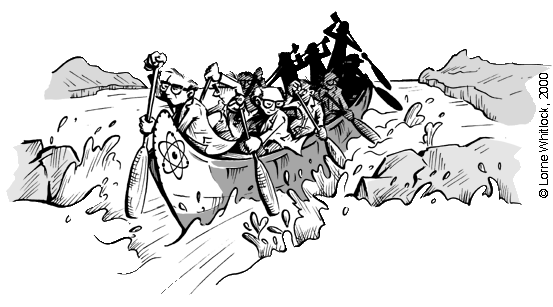Published in the November 2000
issue of the Canadian
Nuclear Society Bulletin, Vol.21, No.3. Artwork
courtesy of Lorne
Whitlock.
GREAT EXPECTATIONS by Jeremy Whitlock Taking the Long View comes naturally to a career nuclear employee. Well-accustomed to the feints of fortune, the parries of politicians, the antics of anti-nukes, today's veteran Atomic Warrior is surprised only when events unfold in a timely and entirely logical manner. Seldom is he or she surprised. The Long View, of course, is that nuclear power's value will continue to appreciate, here and around the world. It has to. Options are limited, particularly as true life-cycle costs sneak more and more into the bottom line. The cause célèbre of anthropogenic Climate Change, fact or fiction, is only the tip of the melting iceberg. It is with some sense of irony, therefore, that pro-nukes receive news of their technology being a "sunset industry", as is sometimes heard. In fact it is very easy to characterize the nuclear industry this way -- one need only note the number of reactor orders in the last ten years and compare with, say, snowmobiles. Factor in government R&D subsidization and you've got the makings of a great public smear campaign. It's easier than falling off a log and much more lucrative if done right. As the manure lobs overhead, the nuclear trenches teem with oblivious activity. The immediate outlook is typically obscure: "good prospects", "potential sale", "favourable climate", "maybe next year". Most of it hinges upon glacial-speed politics and billion-dollar financing that tantalize perpetually from beyond the six-month horizon. And yet, so colossal are the benefits to humankind of one single reactor sale anywhere on the globe, that to the earnest soul it all seems worthwhile. Paddling on the Ottawa River by canoe, the introspective nuclear scientist (with a weakness for metaphor) is reminded of this aspect of his profession. The mighty waterway flows past Chalk River Laboratories with an immensity that renders visual depth perception useless. Particularly when travelling down the middle of the mile-wide river, the illusion of zero progress can be disconcerting to the neophyte canoeist. So vast is the watercourse that you typically see your destination for five hours before arriving, all the while thinking it is only 30-minutes away. One is often given to glancing back at his meagre wake for reassurance that the canoe is actually moving. Even so, the avid Big Water canoeist forges on, stroke begetting stroke, absorbing sounds and scenery with the perspicacity of a wine expert at his craft -- certain that he will eventually arrive where he's going and be richer for the journey. Up ahead Wolsong and Cernavoda loom on the horizon; NG CANDU can barely be made out further beyond. Qinshan towers to starboard. Far off the stern Akkuyu slips forever into the mist. This isn't the life for everyone. Certainly not the ubiquitous motorboat enthusiasts, with the roar of the engine in their ears and the smell of oil in their nostrils. These are the Nortels, the Microsofts, the JDS Uniphases. Nor is it for thrill-seeking kayakers, careening over watery precipices and surfing in the frothy back-fill. These are the Dot-Commers and the day traders. Then there are the hellish Personal Water Craft -- screaming, self-indulgent pests that circle tirelessly in their own wake, lurching haphazardly as the whims dictate. These are the anti-nuclear forces, the living embodiment of a little knowledge being a dangerous thing. These are the armchair safety analysts who overnight become experts on the qualification of MOX transport containers. They spew their ignorant detritus into the mainstream media like a Sea-doo spews its oil slick into the Ottawa. Occasionally an OPP patrol boat pulls alongside to confirm compliance -- bailer, life-jackets, 50 feet of floatable rope, whistles. A bit over-regulated for flat-water canoeing you think. These are ... well, perhaps that one's obvious. When the wind is in your favour the going is good. More often, it seems, a challenge is afoot and the stroke compensates. On the open water great swells can raise you momentarily and improve the forward perspective. Look, the CNF is just around the bend. No not that bend, the next one. Rollers come in from the wake of an unseen boat. It is best to spot these at a distance and manoeuvre accordingly. The paddler inattentive to developing side disturbances can have his boat rocked a little harder than he bargained for. A sudden gust of wind can stop you in your tracks, maybe turn you about and send you where you don't want to go. On the Big Water these often portend greater grief and the experienced paddler knows there's a time to fight, and a time to head for shore and lie low. But it's the underlying sublime struggle -- the dogged quest for unseen grails, despite apparent futility and popular misconception -- that sets both Big Water canoeists and nuclear employees a breed apart. Staying in the game requires not just the Long View, but the stamina to get there. Quitting is, after all, as easy as falling out of a canoe.

| ||||
|
Discussion welcome.
©2011 Jeremy Whitlock
| ||||
|
|
